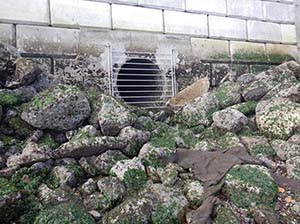During heavy rainfall, sewer pipes and wastewater treatment plants can get overwhelmed as they have a limited capacity and cannot manage all the additional rainwater.
When this happens, CSOs occur because the combined sewers direct excess rainwater runoff and untreated sewage into receiving waterbodies around Vancouver – like False Creek, the Fraser River, and Burrard Inlet. This helps prevent back-ups and flooding of properties served by the sewage and drainage system, but can impact ecosystem health and public access to water. CSOs also happen due to damage to pipes, power outages, or an equipment malfunction. CSOs caused by heavy rain are usually highly diluted by rainwater.
In dry weather or light rainfall, sewage is carried to a wastewater treatment plant where it is treated prior to release.
Protecting public health and the environment
The sewer system was originally designed to allow CSOs in order to protect public health and the environment by preventing treatment plants or buildings from getting flooded.
We have been working towards eliminating CSOs for many decades, largely through sewer separation which replaces combined sewer pipes with separate pipes for sewage and rainwater runoff. We are now also incorporating green rainwater infrastructure to help achieve our goal.

CSO outfall locations
Sewer outfalls vary in size and location depending on the specific design requirements. Some are visible during low tide and others are always underwater.
CSO outfalls are located throughout Vancouver’s shorelines. The locations of City of Vancouver-owned CSO outfalls are shown on the map below.
Metro Vancouver, the organization responsible for the delivery regional utility services, also owns outfalls around Vancouver. Use Metro Vancouver's real-time sewer overflow map External website, opens in new tab to view live overflow.
Information for recreational water users
Follow personal safety precautions for swimming in Vancouver waterways.
Before swimming in any natural waterbody, refer to Vancouver Coastal Health External website, opens in new tab for information about water quality at beaches, current swim advisories, and precautions you can take.
How you can help protect our waterways
- Keep trash out of yards and streets where it can be swept into adjacent waterways by rain or melting snow.
- Don’t pour chemicals down the drain, on the ground, or into catch basins. This could contaminate the soil, groundwater, or nearby surface water. Motor oil, household cleaners, medicines, and other household products contain hazardous or toxic substances that can contaminate ground or surface waters.
- Wash your laundry in cold water to reduce the number of microfibres that are shed from our laundry and improve the health of our oceans. Microfibres from our laundry are one of the largest sources of microplastic pollution in the ocean.
- Adopt a catch basin in your neighbourhood. Before a rainfall, clear your catch basin of debris and litter to prevent it from washing into adjacent waterways or entering our sewer system.
- Pick up after your dog. Feces from animals like dogs and geese can get picked up by rainwater and sent into nearby waterways contributing to high E.coli levels in waters and swim advisories on beaches.
